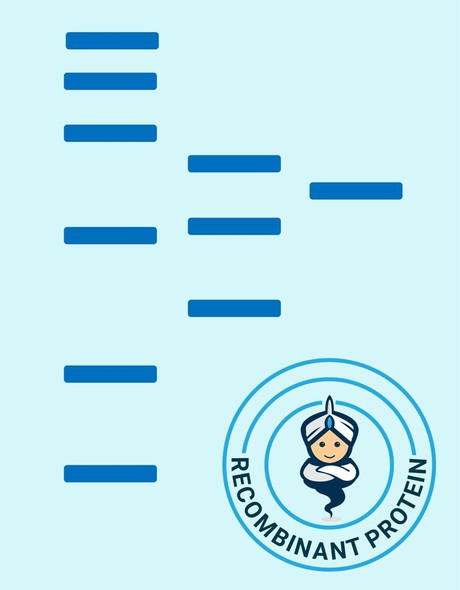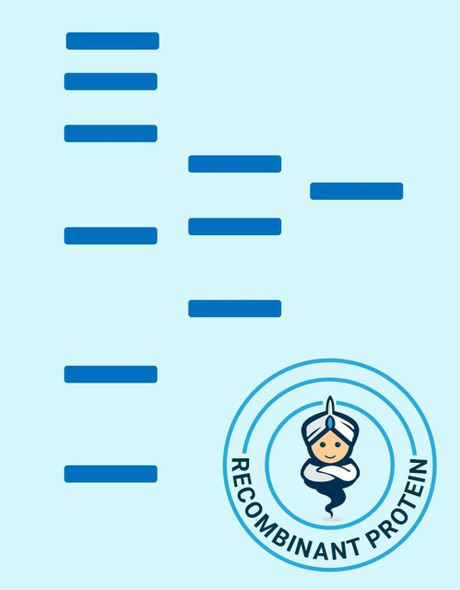Description
| Product Name: | Human RBM8A Recombinant Protein |
| Product Code: | RPPB4420 |
| Size: | 10µg |
| Species: | Human |
| Target: | RBM8A |
| Synonyms: | RNA-binding protein 8A, Binder of OVCA1-1, BOV-1, RNA-binding motif protein 8A, RNA-binding protein Y14, Ribonucleoprotein RBM8A, RBM8A, RBM8, Y14, ZNRP, RBM8B, ZRNP1, BOV-1A, BOV-1B, BOV-1C, MDS014. |
| Source: | Escherichia Coli |
| Physical Appearance: | Sterile Filtered colorless solution. |
| Formulation: | The RBM8A solution (0.5mg/ml) contains 20mM Tris-HCl buffer (pH8.0), 10% glycerol, 0.1M NaCl and 1mM DTT. |
| Stability: | Store at 4°C if entire vial will be used within 2-4 weeks. Store, frozen at -20°C for longer periods of time. For long term storage it is recommended to add a carrier protein (0.1% HSA or BSA).Avoid multiple freeze-thaw cycles. |
| Purity: | Greater than 90.0% as determined by SDS-PAGE. |
| Amino Acid Sequence: | MADVLDLHEA GGEDFAMDED GDESIHKLKE KAKKRKGRGF GSEEGSRARM REDYDSVEQD GDEPGPQRSV EGWILFVTGV HEEATEEDIH DKFAEYGEIK NIHLNLDRRT GYLKGYTLVE YETYKEAQAA MEGLNGQDLM GQPISVDWCF VRGPPKGKRR GGRRRSRSPD RRRRLEHHHH HH |
RBM8A belongs to the EJC (The exon junction complex) which is involved in mRNA export, cytoplasmic localization and nonsense mediated mRNA decay. RBM8A is able to communicate to the cytoplasm the processing history of the mRNA, including the position of the removed introns. Even though RBM8A shuttles to the cytoplasm, it is mostly detected in the nucleus and is colocalized with oskar mRNA at the posterior pole of the cell.
RBM8A produced in E.Coli is a single, non-glycosylated polypeptide chain containing 182 amino acids (1-174 a.a.) and having a molecular mass of 20.9kDa.RBM8A is fused to an 8 amino acid His-tag at C-terminus & purified by proprietary chromatographic techniques.
| UniProt Protein Function: | RBM8A: Component of a splicing-dependent multiprotein exon junction complex (EJC) deposited at splice junction on mRNAs. The EJC is a dynamic structure consisting of a few core proteins and several more peripheral nuclear and cytoplasmic associated factors that join the complex only transiently either during EJC assembly or during subsequent mRNA metabolism. Core components of the EJC, that remains bound to spliced mRNAs throughout all stages of mRNA metabolism, functions to mark the position of the exon-exon junction in the mature mRNA and thereby influences downstream processes of gene expression including mRNA splicing, nuclear mRNA export, subcellular mRNA localization, translation efficiency and nonsense-mediated mRNA decay (NMD). The heterodimer MAGOH-RBM8A interacts with PYM that function to enhance the translation of EJC-bearing spliced mRNAs by recruiting them to the ribosomal 48S preinitiation complex. Remains associated with mRNAs in the cytoplasm until the mRNAs engage the translation machinery. Its removal from cytoplasmic mRNAs requires translation initiation from EJC-bearing spliced mRNAs. Associates preferentially with mRNAs produced by splicing. Does not interact with pre-mRNAs, introns, or mRNAs produced from intronless cDNAs. Associates with both nuclear mRNAs and newly exported cytoplasmic mRNAs. Complex with MAGOH is a component of the nonsense mediated decay (NMD) pathway. Belongs to the RBM8A family. 2 isoforms of the human protein are produced by alternative splicing. |
| UniProt Protein Details: | Protein type:RNA splicing; Translation; Spliceosome; RNA-binding Chromosomal Location of Human Ortholog: 1q21.1 Cellular Component: cytosol; nucleoplasm Molecular Function:mRNA binding; protein binding Biological Process: mRNA 3'-end processing; mRNA catabolic process, nonsense-mediated decay; mRNA export from nucleus; nuclear mRNA splicing, via spliceosome; regulation of alternative nuclear mRNA splicing, via spliceosome; RNA export from nucleus; termination of RNA polymerase II transcription Disease: Thrombocytopenia-absent Radius Syndrome |
| NCBI Summary: | This gene encodes a protein with a conserved RNA-binding motif. The protein is found predominantly in the nucleus, although it is also present in the cytoplasm. It is preferentially associated with mRNAs produced by splicing, including both nuclear mRNAs and newly exported cytoplasmic mRNAs. It is thought that the protein remains associated with spliced mRNAs as a tag to indicate where introns had been present, thus coupling pre- and post-mRNA splicing events. Previously, it was thought that two genes encode this protein, RBM8A and RBM8B; it is now thought that the RBM8B locus is a pseudogene. There are two alternate translation start codons with this gene, which result in two forms of the protein. An allele mutation and a low-frequency noncoding single-nucleotide polymorphism (SNP) in this gene cause thrombocytopenia-absent radius (TAR) syndrome. [provided by RefSeq, Jul 2013] |
| UniProt Code: | Q9Y5S9 |
| NCBI GenInfo Identifier: | 10720244 |
| NCBI Gene ID: | 9939 |
| NCBI Accession: | Q9Y5S9.1 |
| UniProt Secondary Accession: | Q9Y5S9,Q6FHD1, Q6IQ40, Q9GZX8, Q9NZI4, B3KQI9, |
| UniProt Related Accession: | Q9Y5S9 |
| Molecular Weight: | 19,760 Da |
| NCBI Full Name: | RNA-binding protein 8A |
| NCBI Synonym Full Names: | RNA binding motif protein 8A |
| NCBI Official Symbol: | RBM8A�� |
| NCBI Official Synonym Symbols: | TAR; Y14; RBM8; ZNRP; RBM8B; ZRNP1; BOV-1A; BOV-1B; BOV-1C; MDS014; DEL1q21.1; C1DELq21.1�� |
| NCBI Protein Information: | RNA-binding protein 8A |
| UniProt Protein Name: | RNA-binding protein 8A |
| UniProt Synonym Protein Names: | Binder of OVCA1-1; BOV-1; RNA-binding motif protein 8A; RNA-binding protein Y14; Ribonucleoprotein RBM8A |
| Protein Family: | RNA-binding protein |
| UniProt Gene Name: | RBM8A�� |
| UniProt Entry Name: | RBM8A_HUMAN |






